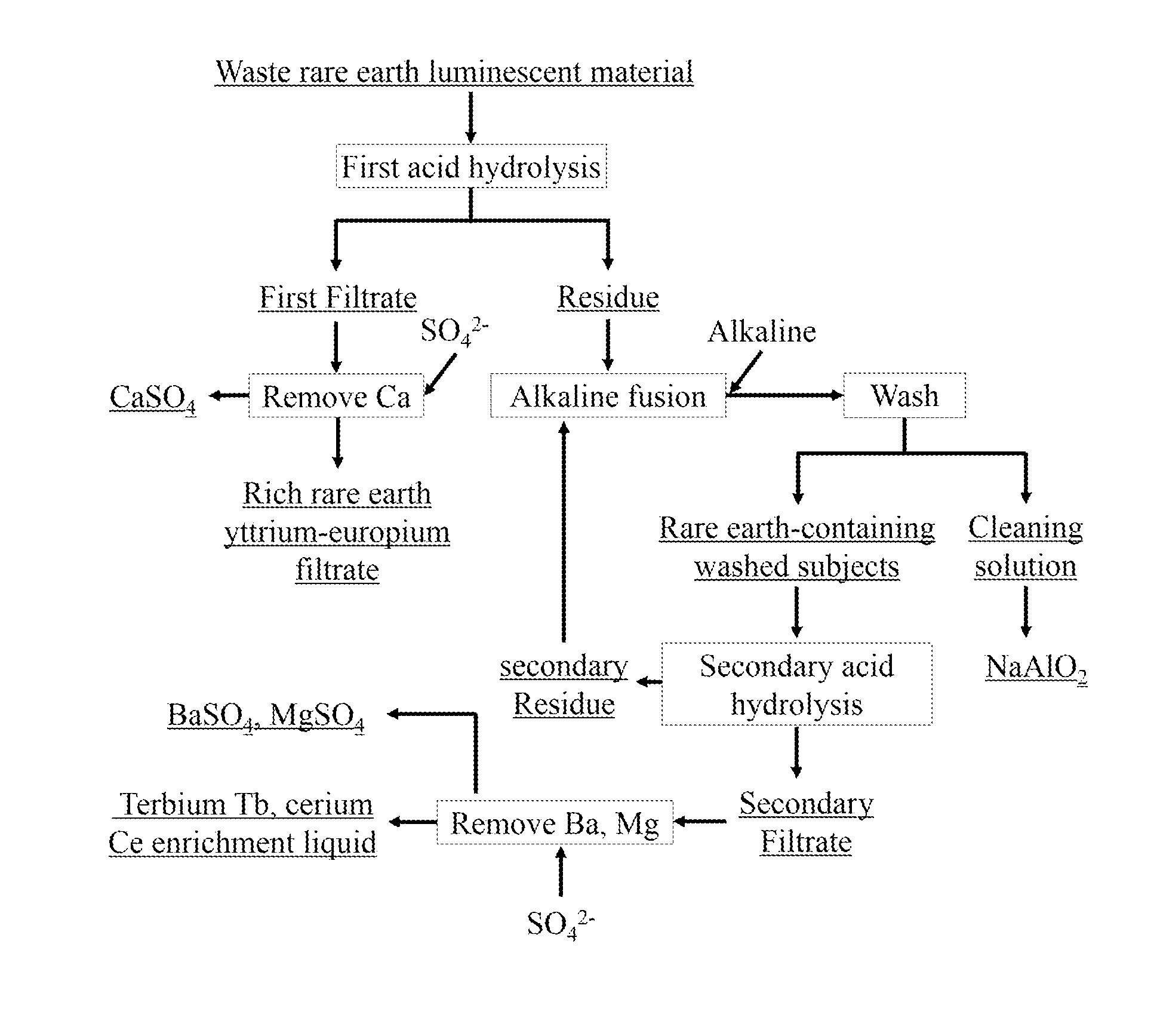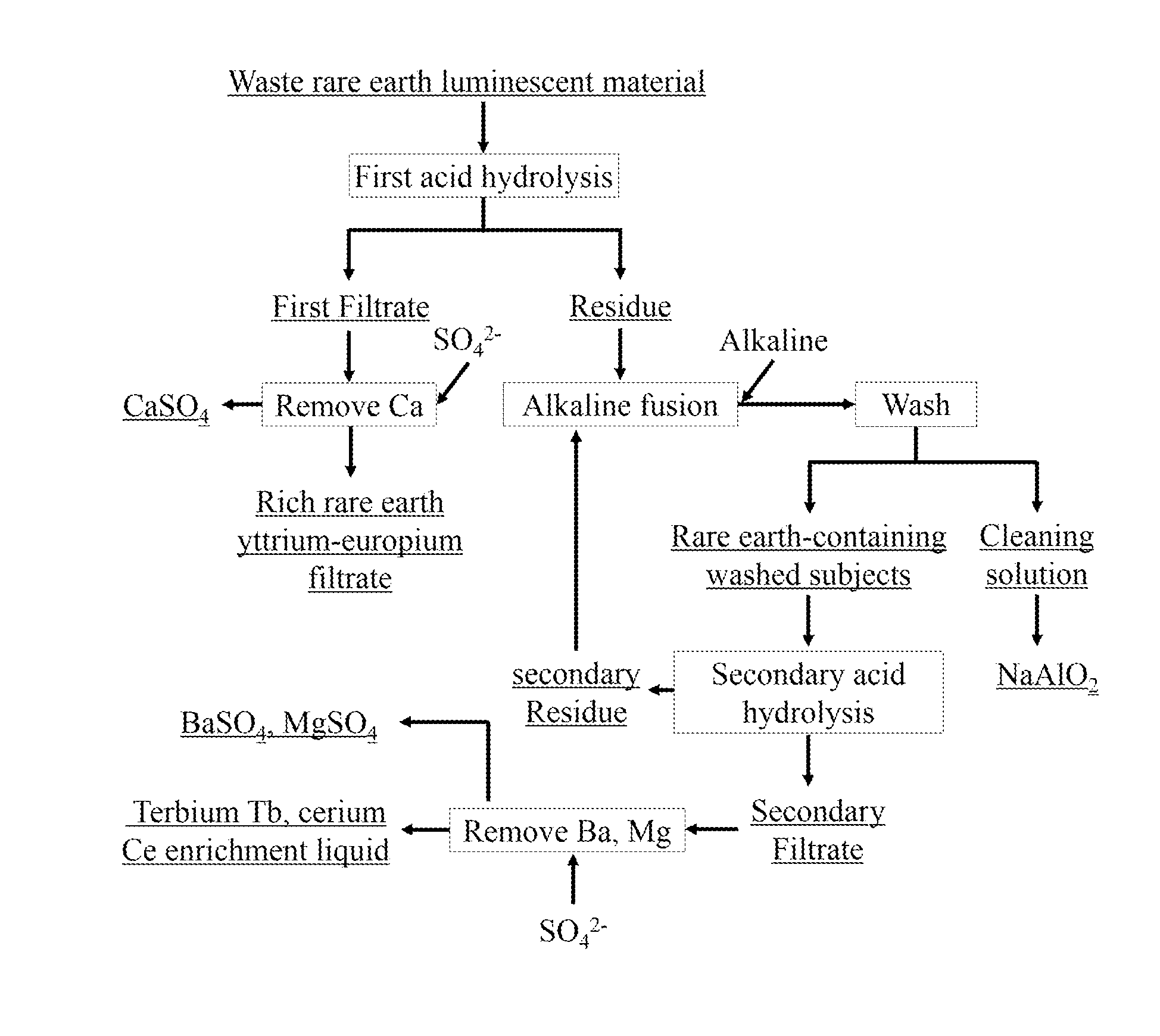Technologies of twice dissolved by hydrochloric acid for waste rare earth luminescent materials
a rare earth resource and hydrochloric acid technology, applied in the field of resource recycling, can solve the problems of large number of unnecessary waste of energy, low extraction solvent efficiency after extraction, and waste of valuable rare earth resources
- Summary
- Abstract
- Description
- Claims
- Application Information
AI Technical Summary
Benefits of technology
Problems solved by technology
Method used
Image
Examples
example 1
[0028]Using HCl solution of 3 mol / L to dissolve waste rare earth luminescent material, in which the solid-liquid ratio was 1:10, the mixture was acid hydrolyzed and stirred for 3 h at 60° C. before the rare earth filtrate 1 was obtained. Adding an appropriate amount of Na2SO4, concentration of 0.5 mol / L, to rare earth filtrate 1, Ca2+ was transformed to CaSO4 precipitation for recycling, while the rich rare earth yttrium-europium filtrate was got, in which yttrium Y accounted for 94.04% of total rare earths, europium Eu accounted for 5.14% of total rare earths. After HCl solution preferentially dissolved the residue, residue and NaOH were evenly mixed as the mass ratio of residue to NaOH of 1 to 4, and alkaline fusion was performed at 500° C. for 6 h, getting alkaline fusion products. Alkaline fusion products were washed several times with deionized water to wash away the NaAlO2. Using HCl solution of 7 mol / L, acid solution of waste rare earth luminescent materials was stirred for 4...
example 2
[0029]Using HCl solution of 4 mol / L to dissolve waste luminescent material, in which a solid-liquid ratio was 1:9, the mixture was acid hydrolyzed and stirred for 4 h at 70° C., before the rare earth filtrate 1 was obtained. Adding an appropriate amount of Na2SO4, concentration of 1 mol / L, to rare earth filtrate 1, Ca2+ was transformed to CaSO4 precipitation for recycling, while the rich rare earth yttrium-europium filtrate was got, in which yttrium Y accounted for 93.38% of total rare earths, europium Eu accounted for 5.02% of total rare earths. After HCl solution preferentially dissolved the residue, residue and KOH were evenly mixed as the mass ratio of residue to KOH of 1 to 3, and alkaline fusion was performed at 600° C. for 7 h, getting alkaline fusion products. Alkaline fusion products were washed several times with deionized water to wash away the NaAlO2. Using HCl solution of 8 mol / L, acid solution of waste rare earth luminescent materials was stirred for 5 h at 80° C., in ...
example 3
[0030]Using HCl solution of 5 mol / L to dissolve waste luminescent material, in which the solid-liquid ratio was 1:8, the mixture was acid hydrolyzed and stirred for 5 h at 80° C., before the rare earth filtrate 1 was obtained. Adding an appropriate amount of Na2SO4, concentration of 1.5 mol / L, to rare earth filtrate 1, Ca2+ was transformed to CaSO4 precipitation for recycling, while the rich rare earth yttrium-europium filtrate was got, in which yttrium Y accounted for 92.98% of total rare earths, europium Eu accounted for 5.08% of total rare earths. After HCl solution preferentially dissolved the residue, residue and NaOH were evenly mixed as the mass ratio of residue to NaOH of 1 to 2, and alkaline fusion was performed at 700° C. for 8 h, getting alkaline fusion products. Alkaline fusion products were washed several times with deionized water to wash away the NaAlO2. Using HCl solution of 9 mol / L, acid solution of waste rare earth luminescent materials was stirred for 6 h at 20° C...
PUM
| Property | Measurement | Unit |
|---|---|---|
| mass ratio | aaaaa | aaaaa |
| mass ratio | aaaaa | aaaaa |
| mass ratio | aaaaa | aaaaa |
Abstract
Description
Claims
Application Information
 Login to View More
Login to View More - R&D
- Intellectual Property
- Life Sciences
- Materials
- Tech Scout
- Unparalleled Data Quality
- Higher Quality Content
- 60% Fewer Hallucinations
Browse by: Latest US Patents, China's latest patents, Technical Efficacy Thesaurus, Application Domain, Technology Topic, Popular Technical Reports.
© 2025 PatSnap. All rights reserved.Legal|Privacy policy|Modern Slavery Act Transparency Statement|Sitemap|About US| Contact US: help@patsnap.com


